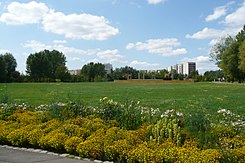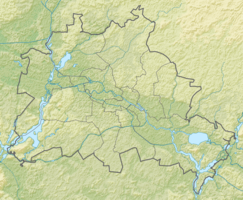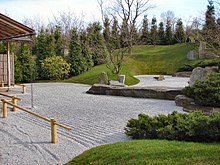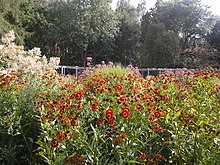gardens of the World
| Gardens of the World Marzahn Recreation Park |
||
|---|---|---|
| Park in Berlin | ||

|
||
| Basic data | ||
| place | Berlin | |
| District | Marzahn | |
| Created | May 9, 1987 | |
| Newly designed | 2000, 2013-2017 |
|
| Surrounding streets |
Blumberger Damm , Eisenacher Strasse |
|
| Buildings | Plant halls, restaurants | |
| use | ||
| User groups | Foot traffic ; Leisure , events | |
| Park design | Gottfried Funeck (initial design; additional landscape architects for all new parts in the 2000s) | |
| Technical specifications | ||
| Parking area | 430,000 m² | |
|
52 ° 32 '22 " N , 13 ° 34' 36" E
|
||
The Gardens of the World Park (1991-2017: Marzahn Recreational Park ) is located at the northern foot of the Kienberg in the Marzahn district of Berlin in the Marzahn-Hellersdorf district . The park was opened on May 9, 1987 on the occasion of the 750th anniversary of Berlin according to plans of the then City Garden Director in East Berlin , Gottfried Funeck, as a Berlin garden show and a gift from the gardeners to the capital of the GDR . At that time it covered around 21 hectares and formed a counterpart to the Britzer Garten , which was inaugurated in 1985 for the BUGA in West Berlin .
Together with the adjacent, freely accessible recreational areas of the Kienberg and the Wuhletal directly to the east, this results in a total area of more than 100 hectares. The park is operated by Grün Berlin Park und Garten GmbH , a company of the State of Berlin that also operates other gardens and parks. The park can only be visited for an entrance fee.
history
A Chinese garden, a Japanese garden, a Turkish garden and a renaissance garden were supposed to be built in the diplomatic quarter south of the zoo as part of the 1995 Federal Horticultural Show , but with the political change in 1989, all of these plans were abandoned. Between 1985 and 1987, a 21 hectare park for the Berlin Garden Show (BEGA) was built at the foot of the Kienberg in the Marzahn district . The green planning began in 1977, the plan was to build a 200-hectare park landscape with a swimming pool, restaurant, sports and leisure facilities and allotment gardens, but the concrete planning for the Berlin Garden Show did not begin until 1985. After a two-year construction period, the Berliner Garden show opened on May 9, 1987 on the occasion of Berlin's 750th anniversary.
The Berlin Garden Show was held from May 9th to autumn 1987. For this Berlin garden show in 1987, extensive meadows, lavishly curved paths and numerous themed gardens and other attractions were created. There was also a rhododendron grove, the spring and spring garden, the Karl Foerster perennial garden , the flower theater, a boulder gallery, a herb garden, five (thematic) allotments, a petting zoo, fairy-tale characters by the Berlin sculptor Gorch Wenske, two arched binder membrane halls, a beer tent and a flower hall that showed other hall shows every week. The dancing fountains , a half-hourly water feature with music and colored underwater spotlights, complemented the attractions. After the garden show in autumn 1987, the park continued to be operated by the City Garden Authority, which is part of the Berlin City Administration. From 1988 onwards, the Stadtwirtschaft Kombinat took over the maintenance of the park area with its urban green department. After the reunification of the city of Berlin , the management and maintenance of the park was transferred to Britzer Garten GmbH in September 1991, which was converted into Grün Berlin GmbH. At the beginning of the 1990s, the park was renamed the Marzahn Recreation Park and large playgrounds and lawns were created, as well as new playgrounds and other trees were planted.
The Gardens of the World project came into being at the end of the 1990s .
- In October 2000, the Chinese Garden (Garden of the Reclaimed Moon) and im
- May 2003 the Japanese Garden (Garden of Confluent Water) opened.
- In December 2003 came the Balinese Garden (Garden of the Three Harmonies) and im
- July 2005 the Oriental Garden (Garden of the Four Rivers) was added.
- A year later in April 2006 the Korean Garden (Seoul Garden) and im
- June 2007 maze and labyrinth .
- At the beginning of March 2008 the newly designed Karl Foerster perennial garden was reopened.
- In May 2008 the Italian Renaissance Garden (Giardino della Bobolina) was open to the public.
- The Christian Garden was opened on April 29, 2011 .
In 2008 the Berlin Senate decided to apply for the 2017 International Garden Exhibition (IGA). A year later, in autumn 2009, the decision was made that Berlin would host the “IGA 2017” on Tempelhofer Feld . On September 18, 2012, the Senate then made the decision to hold the IGA in the Marzahn recreation park (“Gardens of the World”) instead of on the Tempelhofer Feld. The concrete planning began, whereupon the site was expanded to 43 hectares and rebuilt between 2013 and 2017 . In 2014 and 2016, visitors were able to visit the construction site on open days . The Leitner AG built from March to September 2016, the cable car and it was opened on 13 April 2017th This cable car is 1.5 kilometers long and takes a five-minute ride from the “Kienbergpark” valley station at the Kienberg underground station (Gardens of the World) via the “Wolkenhain” middle station to the “Gardens of the World” mountain station on Blumberger Damm, near there Entrance. With the opening on April 13, 2017, the English Garden , the Park Stage (arena), the visitor center with exhibition area and adjoining gastronomy, the International Garden Cabinets from five continents were added. The Balinese Garden, which has existed since December 2003, was expanded to include a new tropical hall. The IGA was held from April 13th to October 15th, 2017 and during this time the Gardens of the World celebrated their 30th anniversary on May 9th, 2017.
After the IGA, a 6-week conversion phase was necessary. Afterwards, the Gardens of the World and the gondola were available to visitors again on December 1, 2017. The last project for the time being will start in October 2019: the Jewish Garden . On June 15, 2019, the 40th anniversary of the Marzahn-Hellersdorf district was celebrated with a colorful supporting program in the Gardens of the World.
Park
overview
The large fenced area includes several gardens that show typical plants and designs from different parts of the world. In addition to the themed gardens, which had been further developed since the foundation, other parts were added to the overall complex .
Chinese garden
The Garden of the Reclaimed Moon is the largest Chinese garden in Europe. The hour of birth was the conclusion of a city partnership between Berlin and Beijing in 1994 . The garden was designed according to plans by the Beijing Institute for Classical Garden Architecture. The entire construction was carried out with materials from China by skilled workers from Beijing. As a classic Chinese scholarly garden, it is characterized by simplicity and subtle colors (gray, white and red). A 4500 m² lake and the “Berghaus zum Osmanthussaft” tea house and a zigzag bridge form the elements of Chinese buildings.
- Size: 27,000 m², of which 5000 m² is a pond
- Opening: October 15, 2000
Japanese garden
The garden of the confluent water is laid out as a Japanese garden . The project was created as part of the city partnership between Berlin and Tokyo . The garden designer, Zen priest Shunmyō Masuno (枡 野 俊明, Masuno Shunmyō) planned the garden (Yū Sui En) and the pavilion (Nyo Sui Tei) as a closed overall complex since 2001.
- Size: 2,700 m²
- Opening: April 30, 2003
Balinese garden

The garden philosophy of Bali was used as the basis for the garden of the three harmonies . The garden in the tropical hall emerged from the partnership between Berlin and Jakarta . The structural elements of the garden designed by the Indonesian architect I Putu Edy Semara were largely prefabricated in Bali and assembled by Balinese skilled workers in Berlin. The garden is housed in the “warm house” of the 14 meter high hall, the neighboring “cold house” is used for exhibitions in summer and as an orangery in winter . As part of the “IGA Berlin 2017”, the exotic facility in the energy-efficient tropical hall built by “Haas Architects” was redesigned and the tropical area around the Balinese garden was expanded to 2000 square meters.
- Size: 500 m² in a lightweight hall
- Opening: December 18, 2003
Oriental garden
The Garden of the Four Rivers was laid out on the model of a Chāhār Bāgh . The “Reception Hall” is part of the Oriental Garden. The garden and landscape architect Kamel Louafi has been planning the complex since spring 2002 and the authenticity of the Moroccan garden historian Mohammed El Fai'z has been checked. The oriental garden combines the gardening traditions of different countries in the Orient . It represents an image of paradise . Ornamental and useful plants were planted in combination and meet the need for shade, color, fragrance and taste that is missing in the desert.
- Size: 6100 m²
- Opening: July 7, 2005
Korean garden
The Seoul garden was designed according to the traditional Korean garden culture as a varied, natural landscape with four courtyards (Ma-Dang) enclosed by walls, rich figurines and a pavilion by the water (Kye Zeong). The Lord Mayor of Seoul visited Berlin in September 2003 and both mayors spoke out in favor of building a Korean garden as part of the “Gardens of the World” project. Korean craftsmen built the garden in Marzahn-Hellersdorf in 2005 and mainly used original construction elements from Korea for the pavilion, the walls and the works of art. The city administration of Seoul developed the project and gift from the city of Seoul to Berlin on the occasion of the Asia-Pacific Weeks 2005. The elements of the garden are the real natural landscape of Korea with rocky landscape, pines , bamboo , oaks and Japanese maples . The courtyards are surrounded by designed gates. The pavilion, built on rocks, stands directly on the water and has living spaces typical of Korea. Abstract figures (Zang Sung and Buk Su) on paths and in front of the walls of the courtyards go back to the shamanic worldview . The tall masts with abstract birds at the top symbolize the shamanistic spirit mast (Sot Dä), they carry the prayers to the spirits in the upper worlds.
- Size: 4000 m²
- Opening: March 31, 2006
Hedge maze and paving labyrinth
This complex was designed on the model of the maze of Hampton Court Palace from England in the 17th century and the floor labyrinth in the Gothic Cathedral of Chartres from France around 1230. Both parts are different. While there is only one way to the center and back out of the labyrinth, a maze is a complex system of paths with crossings and dead ends. The maze was made up of more than 1200 tall yew trees and the labyrinth as a floor mosaic with design elements of European garden art. The entrance to the center of the maze is flanked by two large blocks of granite. In the middle, next to a ginkgo tree, there is a blue observation tower, from the top of which it is possible to see the maze and the labyrinth.
- Size: 1800 m² of hedges and 340 m² of paving
- Opening: June 22, 2007
Karl Foerster perennial garden
The basis of this area is the model of Karl Foerster's garden in Bornim . This facility is an example of German horticulture from the beginning of the 20th century. It was opened on the 134th birthday of Karl Foerster.
- Size: 3600 m²
- Opening: May 9, 1987, expansion and renovation followed in 2007/2008, new opening: March 9, 2008
Italian renaissance garden
The Renaissance garden is called "Giardino della Bobolina" and refers to a 1.30 meter high marble figure in the Boboli Garden in Florence , one of the Italian gardens of the 16th century. Characteristic are the restriction of the stylistic devices, its manageable size and clear shapes. It should give the impression of the villa gardens in Tuscany with stone fountains, terracottas and ancient sculptures. Box hedges form the parterres , flower and ornamental plantings complement the garden with orange trees, high rose trunks in pots, topiary trees made of box trees and perennials and lawns. In the "Giardino segreto" gravel paths convey the "private" ambience with slabs, pavement and stairs made of light gray sandstone , a wall fountain in a niche with tuff stone and recessed water jets is reminiscent of a grotto .
- Size: 3000 m²
- Opening: May 31, 2008
Christian garden
It is a replica of a medieval monastery garden . It consists of a walkway around a square garden area made of gold-lacquered aluminum profiles into which text passages from the Old and New Testament have been incorporated. The typographical design was done by Alexander Branczyk . A four meter high beech hedge surrounds the area. Oriented towards the principle of order of a cloister, this archetype is interpreted in a modern way. The garden was built in a two-year construction period based on a design by the Berlin office “relais Landschaftsarchitekten” and invites you to read in the gold-colored, light-flooded walkway around the square inner courtyard. At first there was a dispute about the name, as originally no garden should be named after a religion.
- Size: 1000 m²
- Opening: April 29, 2011
English garden
The English Garden has a typical English thatched cottage that of roses and perennial beds, a vegetable garden and fruit tree grove surrounded. The main entrance on Blumberger Damm marks the manor house with a view of the English Garden with its cottage . Walls and hedges separate the individual areas. The design was linked to the IGA adopted in 2012.
- Size: 6000 m²
- Opening: April 13, 2017
Jewish garden
From October 2019, another thematic garden will be created on the park area: the Jewish Garden . The management had announced a competition for the design, which the team atelier le balto landscape architects won together with the artists Manfred Pernice and Wilfried Kuehn . In harmony with the already existing themed gardens ( Christian and Oriental garden ), another great world religion will be designed with plants and symbolic elements.
- Opening: (expected) spring 2020
Other plants
The park is barrier-free and has received the prestigious English Green Flag Award .
- Flower beds: planting changes depending on the season
- Flower theater (built in 1987, restoration in 2002)
- rose Garden
- Rhododendron grove with fairy tale characters from twelve fairy tales by Hans Christian Andersen and the Brothers Grimm
- Grass ribbon
- Waterway with 17 bubbling fountains, boulders, clay balls and millstones
- "Promenade Aquatica" water gardens
- Water playground
- Tea house in the Chinese garden
- Stone boat
- Marzahn lookout
- New construction of the visitor center
planning
The Gardens of the World are to be expanded to include a multifunctional hall. The Berlin Senate has approved 19.8 million euros for a large botanical exhibition hall. The 4600 m² multifunctional hall will be built by 2021 for a permanent exhibition, the “microcosm of the garden”, in order to supplement the highly weather-dependent offerings of the gardens with a weatherproof offer. The aim is to make the facility more attractive, especially for tourists.
Kienbergpark
The 60 hectare complex of the Kienbergpark - directly adjacent to the Gardens of the World - was designed for the IGA 2015-2017 and is not in itself connected to the large complex. Here on Hellersdorfer Straße there is also a terminus of the 1.5 kilometer long cable car. The park type is emphasized as special, as references to urban and landscape areas and to the gardens of the world were made. A 30-meter-high observation structure was erected on the 110-meter-high Kienberg. This walkable "cloud grove" offers a panoramic view of the east of Berlin and the Brandenburg cultural landscape. The Kienbergterrassen were created on the southern slope and the 300-meter-long Hellersdorf and Marzahn connecting “Wuhlesteg” were laid across the Wuhletal . The entrance to the Kienbergpark is a town square with the “Belvedere”, the “Märkischer Garten”, the “Elektropolis” youth playground and the Hellersdorf valley station of the gondola lift. Contrary to the fears of residents, the previously freely accessible areas were released again as a public park after the IGA . On the other hand, the use of the Kienbergpark is controversial because of the grazing of the Wuhletal.
Awards
The Gardens of the World were awarded the "European Garden Prize 2019/2020" of the European Garden Heritage Network in the category of garden cultural heritage in Europe .
Visitor numbers
In 1995 the number of visitors was 132,000, in 2003 there were 374,000 visitors, whose tickets covered 40 percent of the costs. While 460,000 guests visited the park in 2006, there was another visitor record in 2007 with over 650,000 visitors, and in 2014 more than 800,000 guests came to the park. In 2017, when the park was part of the International Horticultural Exhibition , the number of visitors rose to 1,600,000, but the expected 2 million guests stayed away and the state treasury suffered a financial failure. The rainy summer weather was one of the causes. Some of the facilities of the IGA were dismantled. Contrary to the forecasts, the number of visitors increased, and the gardens of the world have gained further traction thanks to the new facilities built during the IGA. In 2016 around 428,000 visitors were counted and in 2018 there were far more than 600,000. As part of the overall concept of Grün Berlin GmbH, 800,000 visitors are targeted for this park. For this purpose, the stream of visitors should be directed from the city to the outskirts, since "the Marzahn facility is one of the" top three "special parks in Europe, we have a unique selling point."
Web links
- gardens of the World
- General plan
- Website of the IGA Berlin 2017
- Gardens of the world . Senate Department for Environment, Transport and Climate Protection
- Cable car "Gardens of the World - Berlin"
Individual evidence
- ↑ On the death of Gottfried Funeck. ( Memento from October 29, 2016 in the Internet Archive ) In: Stadt + Grün , 5/2011, p. 71 (PDF)
- ↑ Berlin garden show opened for the city anniversary. In: Neues Deutschland , May 11, 1987, p. 1.
- ↑ Hinnerk Dreppenstedt: Gardens of the World in Berlin . Nicolai, Berlin 2011, ISBN 978-3-89479-630-3 , pp. 9 .
- ↑ a b Berlin Garden Show 1987. Retrieved June 11, 2019 .
- ↑ Shaping the green metropolis
- ↑ a b Gardens of the World / State of Berlin. Retrieved June 13, 2019 .
- ^ IGA Berlin 2017 / State of Berlin. Retrieved June 13, 2019 .
- ↑ Cable car in Berlin International Garden Exhibition 2017. October 22, 2017, accessed on June 13, 2019 .
- ^ A Jewish garden for Berlin
- ↑ Julia Haak: Marzahn is now getting a Jewish garden . In: Berliner Zeitung , November 12, 2018.
- ↑ The party district. May 30, 2019, accessed June 14, 2019 .
- ↑ Birthday party in the gardens of the world
- ↑ Chinese Garden in the Gardens of the World
- ↑ The Balinese Garden in the new tropical hall .
- ^ Korean Garden (Seoul Garden) at the Senate Department for Environment, Transport and Climate Protection.
- ↑ Gardens of the World - Maze and Labyrinth at the Senate Department for Environment, Transport and Climate Protection
- ↑ Karl-Foerster-Perennial Garden at the Senate Department for Environment, Transport and Climate Protection
- ↑ Selected green spaces in Marzahn-Hellersdorf: Italian Renaissance garden at the Senate Department for the Environment, Transport and Climate Protection
- ↑ Jürgen Siebert: The “Christian Garden” can grow. (No longer available online.) In: Fontblog. FontShop , March 21, 2011, formerly in the original ; Retrieved September 18, 2015 . ( Page no longer available , search in web archives ) Info: The link was automatically marked as defective. Please check the link according to the instructions and then remove this notice.
- ↑ a b c Christian garden. In: berlin.de , accessed July 9, 2011.
- ↑ Gardens of the World - Christian Garden at the Senate Department for the Environment, Transport and Climate Protection
- ↑ Marzahner "Christianization" . In: Berliner Zeitung , August 16, 2010.
- ↑ Description at Stadtgrün on berlin.de
- ↑ English Garden Marzahn The scent of roses . In: Berliner Zeitung , May 16, 2017
- ↑ In 2010, an area of 13 hectares was purchased along the Blumberger Damm. The Austin-Smith office came up with the idea of an English landscape garden: Lord LLP (Manchester, England) designed the facility and the foundation stone was laid in May 2013. The garden was completed in 2016 and the opening was linked to the IGA 2017.
- ↑ Berliner Zeitung , 6./7. April 2019, Supplement Immobilienwelten , p. 3.
- ↑ Multifunctional building is created. In: LichtenbergMarzahnPlus , April 21, 2018.
- ↑ Kienbergpark development measures
- ^ Kienbergpark - A new park landscape in the Wuhletal .
- ↑ Exhibition on Kienbergpark opened . In: Berliner Woche , March 27, 2018.
- ↑ Press release of the Marzahn-Hellersdorf District Office from September 10, 2019
- ↑ Events 2015 in the Gardens of the World , ( Memento from July 22, 2015 in the web archive archive.today ) Press release of Grün Berlin GmbH , January 22, 2015.
- ↑ 1.6 million visitors to IGA . In: Märkische Oderzeitung , October 5, 2017
- ↑ Current news on the development of the International Horticultural Exhibition IGA 2017 in Berlin.
- ↑ Harald Ritter: Increased number of visitors . In: Berliner Woche , December 30, 2018
- ↑ Gardens of the World in the Marzahn Recreation Park on “berlin.de/sehenswuerdheiten”.
- ↑ Birgitt Eltzel: A “very good” for sustainability . In: LichtenbergMarzahnPlus (online newspaper from the east of Berlin), October 10, 2018.
- ↑ In the words of the Grün Berlin boss on top three of the special parks in Europe









